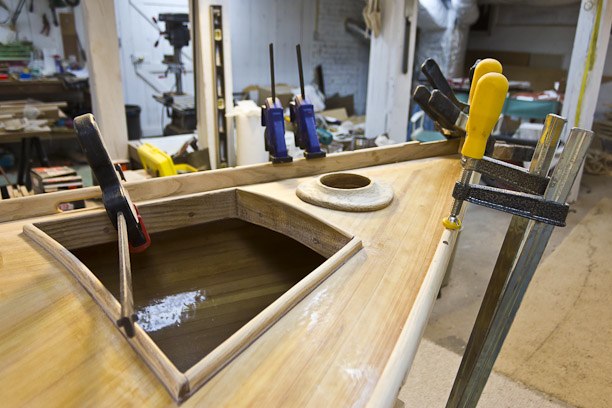 Toe Rails on Caesura installed
Toe Rails on Caesura installed
Installing the Toe Rails took all weekend. It’s a job that needs a lot of planning, preparation, and either a lot of hands or a lot of clamps.
Given the way they’re attached, once on, there’s no easy way to take the rails back off for repairs or to fix mistakes, even if you don’t glue them down. But since Ash is prone to rot, it needs to be sealed in epoxy, and it seemed pretty clear the best plan is to seal everything up tight during installation, on both sets, so no water seeps into seams or screw holes later. Maybe doing that will delay repairs a bit longer. Working with epoxy, though, means a limited window of time for the whole process, start to finish. Everything has to go right.
I did several test fittings, and fine tuned a few bevels. The Spanish Cedar is more flexible and bent true. The Ash, however, is so stiff I could tell it was going to bend more at the scuppers than between, making a bumpy curve. So I left the wood above the scuppers as thick as possible, and will sand them back after the glue sets.
The bronze screws for this are 2” long. They have to go through the rail, the deck, and into the sheer clamp, in countersunk pilot holes. Testing on scraps, it was evident the pilot hole on a standard combination countersink bit was too small. The bronze is so soft the heads strip out before they can be driven home. So I had to carefully drill each hole twice – once for the pilot hole and once for the countersink. The countersinks have to be small enough to fit within the width of the rail, too, making the hole the same size as the screw head, so there’s no margin for error. If the pilot hole is off center a tiny bit you’ll have a real mess, and won’t know it until it’s too late. I spent a lot of time setting up a jig on the drill press, and that part went fine. No way to know how the rest will go until you’re knee deep in it.
With everything ready – clamps on hand, screws laid out, epoxy on the bottoms of the rails, and a thickened bead along the deck – I took a deep breath and dove in. I started the first screw, then held the piece down with one hand while driving it in with the other. The first one went fine. The second screw stripped out part way in. Worse, it stopped just below the surface of the countersink – too deep to grab it, and too shallow for a plug to hide it.
And there was a gap between the rail and the deck.
*%^$^&#&^%(&%^!!!!!
I had visions of destroying weeks of work trying to get the dad-blamed thing off again. Meanwhile, the epoxy was starting to kick off.
*%^$^&#&^%(&%^!!!!!
I got a step ladder so I could stand above it, and with all my weight on the drill, slowly tried to back the screw out. It stripped out again in a quarter turn, but that was enough to get the head flush with the surface. I pulled out some special needle-nose pliers to do emergency surgery, got a tenuous grip on the head, and slowly twisted in tiny increments. Fifteen minutes later the blasphemous thing was out, and no damage done that couldn’t be sanded off.
Whew! Close call.
Obviously, trying to manage the drill with one hand wasn’t going work. Deploying straps and clamps to hold the rail in place, I pulled out a second drill and chucked in the pilot bit. Positioning the rail exactly, I drilled a pilot hole through the deck and sheer clamp, just before inserting each screw. From then on, I’d start the screw until it just caught, then stand on the step ladder above it and press down with both hands to drive them home. No more stripped screws.
Terri got some pictures after the cursing was over.
Aside from cleanup, and some extra clamping, the rest went fine. Another hour of work and it was all done. In a few days the rest of the clamps can come off for sanding and sealing.
melonseed skiff, mellonseed skiff, melon seed, mellon seed











Dang, Man! Looking great! I’ve completely given up on phillips head screws after stripping too darn many of the suckers. Square drive on the brass/bronze has saved many a cussing session. I more than make up the cost difference in the lack of wasted screws.
I remember this phase. “Dang, I’m close. A day here, an hour there and I’ll be sailing!” Months later, “Dang, I gotta stop making predictions….”
Cheers!
Thursday, May 12, 2011 – 06:38 PM
Hey man, dang right. Seems like you’re sooooo close. Then you realize it will take days just to sand and prep one hull for painting. Oh, and there are all those other things, too. If you think about it too much you just get discouraged. Better to keep saying “Just a little long and I’ll be sailing!”
These are all Frearson screws. Better than Phillips, but look the same. They’ve been mostly fine up until this. I guess 2″ screws, an inch and a half of Ash, two layers of Cypress, and two of epoxy and fiberglass, was just asking too much.
Never tried the square heads. Do you use those everywhere, or just where the heads don’t show?
Thursday, May 12, 2011 – 11:54 PM
I use the square heads everywhere. I’ve also gone to using a tapered pilot hole bit (Fuller), especially when I am using the soft screws or hard wood. Some say they don’t hold as well, but if you size the hole right, then you are ok. I’ve used the Frearsons also, but still prefer the square. If I were a real traditionalist I’d be using slotted heads and making sure that every screw has the same exact alignment (even those that are hidden!).
That must have been a scene trying to get the holes drilled, epoxy on, rail bent, and screws in! I’m pretty sure that I did not epoxy the rail in place, for ease of repair/replacement at some future time. Trade-offs.
Getting close to booking my ticket for MASCF this fall!
Friday, May 13, 2011 – 10:28 AM
Hot damn, that’s looking great!
Sunday, May 15, 2011 – 01:01 AM
So…. You suggest Spanish Cedar for the toe rails?
Depends on how you intend to use the boat. Ash is stronger, can take a beating and more impacts without breaking, but the Spanish Cedar was much easier to work with. Either wood is fine. So far, the Spanish Cedar has held up fine, given how these boats are used.
For me, color also was a factor. The red mahogany of the cedar looks good on the white boat, but the ash is better with the dark blue.